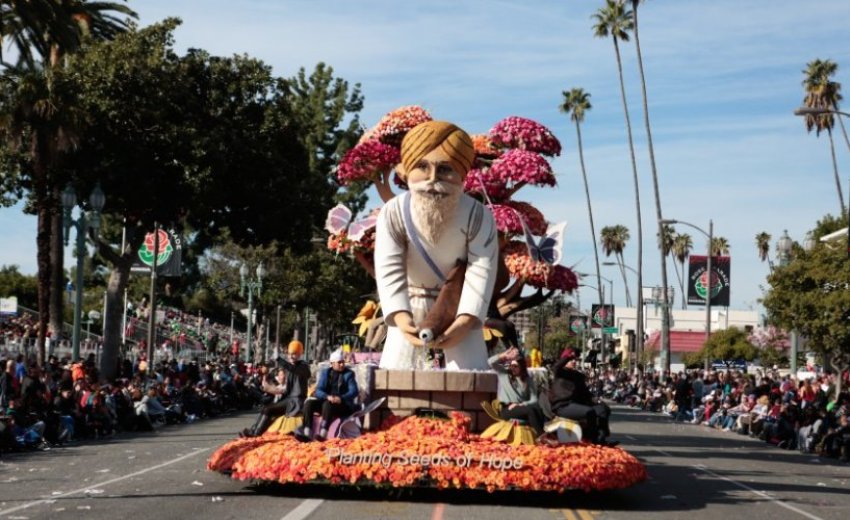The annual Rose Parade is viewed as an educational opportunity by local Sikhs. For the sixth year running, they've made a spectacular float to showcase their beliefs and advocate for "freedom, equality, compassion, and service."
The Sikh American Float Foundation’s entry with a Bhai Ghaneya Ji float made its way to the Rose Bowl Parade route on New Year’s Day in 2020. The Sikhs continued to smile and waved as they passed by the onlookers. The float also had a 12-year non-Sikh boy Miles Lhotka on the float.
Miles Lhotka has been in at least four musicals and understands how to captivate an audience with theatrical motions. But this was the 12-year-first old's time on a Rose Parade float. As he rode along Colorado Boulevard, the young performer tried to radiate confidence, saying ‘Happy New Year’ to onlookers who were filming him on their smartphones. He was still nervous. Perhaps knowing he's a part of something bigger helps calm his nerves.
The Sikh American Float Foundation participated in the parade for the sixth year in a row by driving a float around the 5.5 mile parade route. The float of 2020, which measured 85 feet in length and was themed "Planting Seeds of Hope," was decorated with coffee grinds, lentils, walnuts, cranberries, spices, and flakes of coconut.
Sculptor of Bhai Ghaneya Ji
Maninder Minu Singh, the foundation's creative director, began planning the float's design a year ago. She needed to come up with a way to connect this year's parade theme, ‘The Power of Hope’ with the Sikh faith. So, she eventually decided on a big sculpture of Bhai Ghaneya Singh Ji, an 18th-century Sikh remembered for providing water to wounded troops on the battlefield regardless of their faith.
Maninder along with 1,400 volunteers and the Irwindale-based Phoenix Decorating Co. were able to bring to life the sculpture of Bhai Ghaneya Ji. It was a representation of putting humanity above affiliations and differences, whether based on religion, caste, race or ethnicity.
The float depicted Bhai Ghaneya Ji pouring water while surrounded by 69,000 live roses and 16 actual youngsters. The presence of youngsters from various backgrounds was vital to highlight as they are the future of the world. Sharing her views on the same, Maninder said, “If we plant seeds of love, compassion and service into young minds today, then they can design a world in the future that is more peaceful, kind, loving and beautiful.”
An attempt to resolve hate crimes against Sikhs
While there are thousands of Sikhs in the United States, Sikhism has its origins in India's Punjab area in the 15th century. Mainly because of their appearance and the way they wear turbans, some people mistakenly believe that Sikhs are Muslims. After the 9/11 attack, Islamophobia was on the rise, and the violence against American Sikhs increased.
A shooting rampage in a Sikh temple in the suburbs of Milwaukee in 2012 resulted in the deaths of six people. There was also a rise in the number of complaints detailing hate crimes committed against the group. In fact, the FBI received a total of six reports of hate crimes committed against Sikhs in 2015.
According to numbers released by Brian Levin, director of the Center for the Study of Hate and Extremism at Cal State San Bernardino, the number of incidents of hate crime in 2018 rose to 60, marking a 200% rise from the 20 that were reported in 2017. He also said, “Sikhs are attacked not only because they are confused with Muslims, but also because their adherents are doubly stereotyped.”
Brian Levin also stated that the "great outreach performed by the Sikh community" and modifications in law enforcement data gathering both played a role in the substantial rise in reports.
The Sikhs in the area consider the parade as a teaching opportunity. In order to convey a message of kindness and compassion, it is essential to have a float that celebrates diversity and collaborates with non-Sikhs, like Miles Lhotka. Maninder said, “At the end of the day, we all believe in freedom, equality, compassion and service. Those are the things necessary to blur the lines of division and bring us together.”
Lhotka, who does not adhere to any religious tradition and is white, expressed that the message of compassion is significant to him because it promotes the idea of tolerating differences in order to build equality. The 12-year-old further said, “The human race needs to realize it’s the human race. This is a theme that needs to be more prominent today.”
Through this new initiative, the Sikh community wanted to represent themselves like every minority who contributes to the great nation and deserves to be respected and celebrated.
*Based on an article by Erin B.Logan, published on 1st January 2020 in Los Angeles Times
